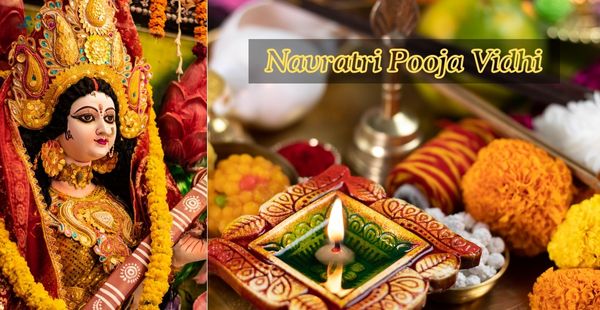
In India, the festival of Navratri is an extravagant celebration of devotion, dance and divine force. For nine nights in a row, worship is offered to Goddess Durga through her nine forms each representing a different aspect of her power, love and wisdom. By performing navratri pooja vidhi sincerely one not only attracts blessings from the goddess but also fills their houses with positivity, peace and divine positive energy during Navratri.
Our blog will walk you through every step of navratri pooja vidhi process so that you can offer your prayers religiously and accurately. This guide will be helpful in aligning yourself with the spiritual essence of the festival whether you are a first-timer or an experienced devotee.
1. Preparation: Cleanse Your Space and Mind
Before any pooja, it is important that you prepare yourself and your house for the sacred rituals. To begin with, clean thoroughly the place where pooja will be conducted; ensure that it is pure and free from any clutter. A clean environment attracts positive energies and helps you prepare your home so that it can receive the divine presence of Goddess Durga.
Spiritual Cleansing: Sprinkle Ganga Jal (holy water) around the house to purify your home.
Personal Cleansing: Take a shower and wear fresh clothes, preferably new ones or those which are well washed in bright colors, such as red, orange or yellow which signify auspiciousness.
Pro Tip: On first day of Navratri wear white or yellow dress symbolizing purity and devotion.
2. Set Up the Sacred Altar (Mandap)
The altar also known as mandap is where all rituals connected to Navratri Pooja take place; this means that its location holds great significance. This place must be calm with no noise from electronics etc., clean free from dirt and heavy objects; westward direction is deemed ineffective hence East or North directions may be used when setting them up although east facing mandaps are more recommended.
Choose a suitable space: Select an appropriate corner at home during this time based on east north facing either preferred according castes.
Install idol/image: Put up Maa Durga’s statue on an elevated wooden platform or cloth; alternatively small figures of Ganesha along with kalash (sacred pot) may add beauty to altar setup.
This should involve decorating the altar with fresh flowers as well as other decorations like leaves garlands rangoli patterns etc.”
3. The Kalash Sthapana (Ghatasthapana)
Kalash Sthapana is the beginning of Navratri and it’s an important ritual that signifies inviting Goddess Durga to your home.
Prepare the Kalash: Fill the Kalash with water, add mango leaves and place a betel nut, a coin and some rice inside it. Now cover up its mouth part using coconut which is wrapped by red cloth.
Place the Kalash: The Kalash must be placed on raw rice or any other grains to represent fertility and abundance.
This symbolizes commencement of Navratri officially asking for divinity feminine energy of Durga into your house.
4. Invoke the Goddess: Durga Avahan
After Kalash Sthapana, it’s time to invoke the Goddess through a ritual called Durga Avahan.
Chanting “Om Dum Durgayein Namah” will invite Goddess Durga into your idol or image.
Keeping burning Akhand Jyoti (eternal lamp) that should last for nine days denotes goddess’s divine power and protection.
One should therefore note that this invocation is quite important since it signifies coming in of Goddess durga’s divine energy into ones Kygo.
5. Naivedya (Offerings), & Flowers
Naivedya, or offerings, hold an important place in Navratri Pooja. They are means of showing one’s reverence and gratitude to Goddesses.
Flowers and Fruits: Fresh flowers like hibiscus, red and marigold should be offered since they are particularly liked by the Goddess Durga. Bananas, coconuts, pomegranates can also be offered as fruits.
Naivedya: One can make traditional Navratri sweet dishes such as kheer, halwa or panchamrit (a mixture of milk, butter milk or yogurt sweetened with sugar). Some devotees also opt for sattvic food like boiled potatoes, fruits or milk products especially if they fast during this period.
Pro Tip: When you offer prayers remember to have kumkum, haldi and akshat (uncooked rice). They stand for purity, prosperity as well as devotion.
6. Reciting Durga Saptshati or other Hymns
Reciting Durga Saptashati is a very important part of Navratri Pooja. This holy text has a total of 700 verses that recount the victory story of the goddess Durga over the demons thus depicting ultimate triumph of good against evil.
For those who feel that the lengthiness of Durga Saptashati is too much there are Durga Chalisa and Devi Stuti which can be recited.
Singing devotional bhajans along with the conclusion of traditional Aarti for Durga makes the atmosphere divine with full of positive energy and devotion.
Pro Tip: The recitation of particular chapters from Durga Saptashati can be done on different days when each coincides dynamically with those types of activities which are related to that specific day’s events.
7. Give Pooja Prasad
After the Aarti and hymn recitations are finished, then offer Prasad to Goddess Durga. Naivedya prepared earlier or other offerings such as dry fruits, makhana or ladoos could serve as this offering.
Since Prasad is believed to be sacred and blessed by the goddess, it must be served to family members and visitors.
8. Perform Kanya Poojan (Ashtami or Navami)
On eighth (Ashtami) or ninth (Navami) day of Navratri, Kanya Poojan is performed. Nine forms of Durga are symbolized by the young girls who are worshipped and honored.
Invite your home nine girls aged between two and ten years if possible. Wash their feet; offer them fresh flowers, tie mauli (sacred thread) around their wrists and serve them food consisting mainly of halwa, puri, and chana, a sort of chick-peas. The Kanya Poojan symbolizes pure divine feminine energy and an immense spiritual merit flows from blessing these young ones.
9. Finish with Visarjan (Dissolve)
On the tenth day, referred to as Vijayadashami or Dussehra, the festival culminates in Visarjan or immersion of the Kalash and a symbolic farewell to Goddess Durga.
Thank goddess for blessing your home and life through final prayers.
Pouring away water from Kalash: This signifies that goddess’ earthly figure has gone off while she is back to where she belongs. The water should either be poured on the ground or taken to river banks.
Conclusion:
In addition to being a means to show reverence to Goddess Durga, the Navratri Pooja Vidhi is also an invitation for a personal quest towards honest purity and personal improvement. Always keep it in mind that the main aspect of the pooja is always found in your faithfulness, honesty and affection divine.
The performance of the Navratri festival rituals serves as an open door through which you can access Goddess Durga’s favours resulting in your protection, abundance and harmony in your home.
Never forget that this is an opportunity we must not miss to be together with God, making us experience happiness and positive things.
May this year’s Navratri help you get much closer to the Almighty leading to a happy life full of achievement in whatever you do.

